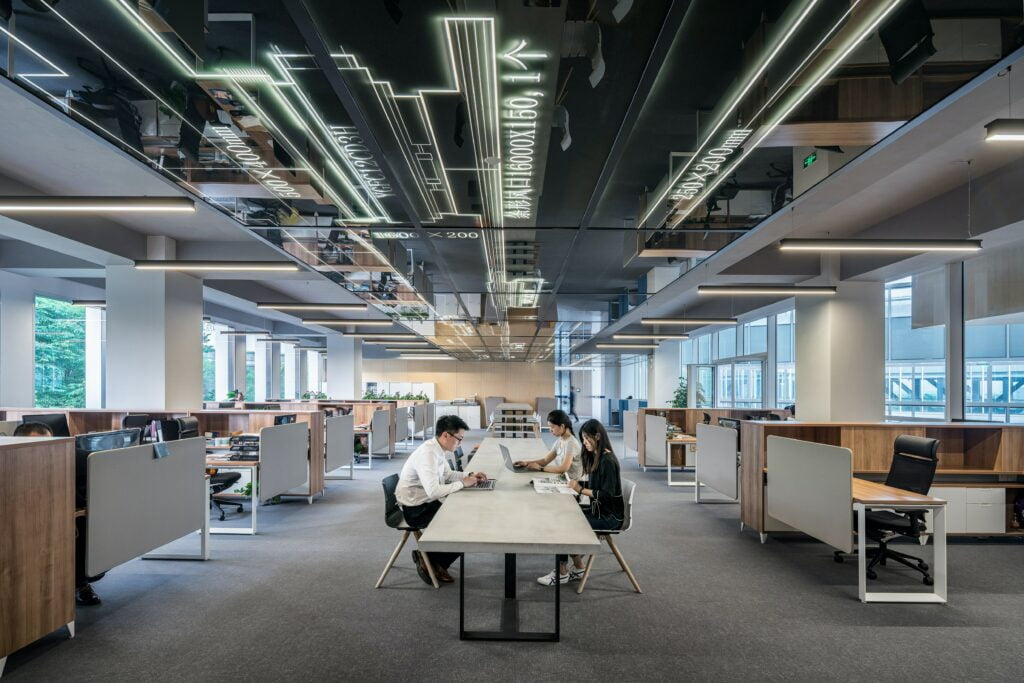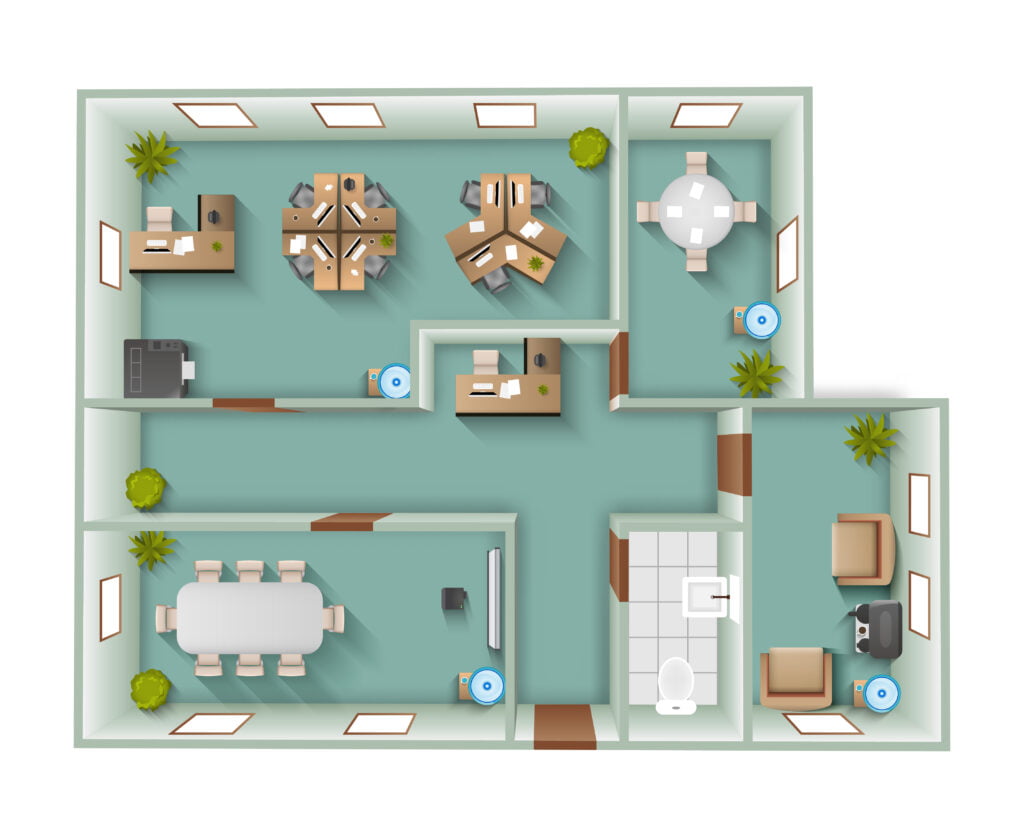
The office space required per person is a key consideration when designing and organising a workplace. This can be influenced by various factors, including the type of work being done, the layout of the office, and the company’s overall size.
Furthermore, with the evolving trends in remote work and flexible office arrangements, understanding how much office space per person is optimal has become even more crucial. Especially for businesses striving to maximise productivity, foster collaboration, and adapt to changing work dynamics. In this article, we’ll explore the various factors that can impact the amount of office space required per person and provide some guidelines for determining the appropriate amount of space for your organisation.
The type of work being done in the office can significantly impact the amount of needed space. For example, an office that primarily consists of desks and computers will likely require less space per person than an office that includes a workshop or laboratory (specialised equipment or tools may necessitate dedicated areas, while collaborative projects might benefit from shared workstations supplemented with breakout areas for ad hoc discussions.). Similarly, an office that requires a lot of collaboration and interaction among employees may require more space to accommodate group meetings and discussions.
An open-plan office, for example, may require less space per person than a traditional office with separate, enclosed cubicles or private offices. This is because open-plan offices typically utilise shared workstations and collaborative working spaces rather than individual work areas for each employee. Beyond mere square footage, the layout influences workflow efficiency and employee interactions. Factors like the proximity of departments, accessibility of communal spaces, and sightlines can all contribute to a cohesive and functional office design that optimises both individual productivity and team collaboration.
The size of the company is another factor that can impact how much office space per person is required. A larger company may require more space per person to accommodate additional number of employees, while a smaller company may be able to utilise shared workspace more effectively. As a company expands, its spatial needs evolve accordingly. Scaling up necessitates accommodating additional personnel and ensuring that the infrastructure supports heightened communication channels, administrative requirements, and communal amenities to sustain a cohesive and productive working environment.
Considering what employees expect from modern office when determining the space is important. Some employees may prefer a more open, collaborative workspace, while others may need a more private, enclosed area to work. Surveying employees to gauge their preferences can help you determine the right balance of open and private space in your office. Acknowledging the diverse preferences of employees fosters a workspace that caters to varying workstyles and personal needs.
The type of furniture used in the office can also impact the amount of office space required per person. For example, using compact, space-saving furniture such as standing desks or multi-purpose tables can help you maximise the available space. Strategic selection of furniture not only maximises space utilisation but also enhances ergonomic comfort and functionality. Incorporating flexible furnishings that can adapt to diverse tasks and preferences fosters a dynamic environment conducive to productivity and well-being.
Some companies may prioritise a more open, collaborative workspace to encourage teamwork and communication, while others may value individual privacy and focus more on enclosed private offices. The office space serves as a tangible manifestation of the company’s values and ethos. Aligning spatial design with cultural priorities, whether emphasising transparency, innovation, or autonomy, reinforces organisational identity and cultivates a cohesive sense of purpose among employees.
There may be many benefits to choosing a prime location, such as better access to transportation and amenities. However, it can be more expensive than space in less desirable areas.
You can choose a less desirable location and get more space for your money. This could be a good option if you have a large team, need a lot of space, or are looking to save money on rent. Keep in mind that a less convenient location may also impact employee morale and retention, so it is crucial to weigh the pros and cons carefully.
Finally, it’s important to consider the potential for company growth when determining the amount of space needed per person in the workplace. If you anticipate adding new employees in the future, it’s a good idea to allocate additional space to accommodate future growth.
While there is no one-size-fits-all answer to this question, there are some general guidelines that can help you determine the appropriate amount of space for your organisation.
According to the International Facility Management Association (IFMA), the average amount of office space required per person is around 150 to 225 square feet (14 – 21 m2). This range is based on the assumption that the office is primarily made up of desks and computers and that employees will be seated for the majority of their workday.
However, if the office includes additional amenities or activities, such as a workshop or a break room, or if the layout of the office is more open and collaborative, you may need to allocate more square feet per employee. In these cases, a good rule of thumb is to aim for around 250 to 350 square feet (23 – 33 m2) per person.
It’s also worth noting that the amount of how much office space per person is needed can vary based on local regulations and standards. Some cities or countries may have specific guidelines for the minimum amount of space for 1 person, so it’s important to research and comply with these requirements.
One of the possible solutions to save some office space, especially for hybrid offices, is to use a shared desks working model. The shared desk is a flexible office seating arrangement where employees can reserve the desk space they desire for hour, day or even week. Instead of having fixed desks, employees can choose a different desk or other type of workspace each day. When they are done working, the desk becomes vacant and available for another employee. Shared desks can be reserved or booked on a first-come, first-served basis or in advance.

Some companies use manual booking through their own created sheets or with office manager help; others choose to use desk booking software that allows companies to manage and optimise the use of desks and other workspaces in an office. These solutions typically allow employees to book desk space in advance or on demand, depending on their needs and availability. By sharing desks between employees, the company can save some office space:
By allowing employees to book desks on demand, a desk booking solution can help reduce the number of fixed desks that a company needs, thereby promoting a more dynamic and adaptable workspace. This can save space and even reduce business expenses, contributing to a more cost-effective and agile operation.
A desk booking solution can help ensure that desks and office space required per person are used efficiently, preventing wasted or empty office space. This is especially beneficial for companies with many flexible or remote workers who may not need a dedicated desk daily.
A desk booking solution can help encourage collaboration by allowing employees to book desks in common areas or near colleagues they need to work with, facilitating spontaneous interactions and idea exchanges. This can foster a sense of community and encourage teamwork while saving space by reducing the need for separate conference rooms and promoting an environment conducive to creativity and innovation.
Technology is transforming how we manage office space, making it easier to optimise and create a better environment for employees. From desk booking software to real-time tracking tools, here’s how different technologies help improve space management:
1. Desk Booking Software
Desk booking software allows employees to book workspaces in advance or on demand. This helps ensure desks are being used effectively. It reduces wasted space and allows employees to choose the best workspace for their needs. Whether for a day or a week, the system gives flexibility and control to employees while streamlining office usage.
2. Real-Time Occupancy Tracking
Real-time occupancy tracking shows how often areas of the office are being used. It helps identify spaces that are too crowded or rarely used. This data is valuable because it helps companies adjust the office layout, optimise seating, and ensure spaces are used efficiently. By using occupancy sensors for better tracking, companies can create work environments that support employee needs, like adding more meeting rooms or freeing up unused areas.
3. IoT Sensors
IoT (Internet of Things) sensors can track things like room temperature, lighting, and the number of people in a space. This information gives companies insights into the office environment, helping them make decisions on improving comfort and energy efficiency. For example, sensors can help adjust lighting and temperature based on room occupancy, ensuring energy isn’t wasted and that employees are comfortable.
4. Space Management Software
Space management software combines data from desk booking, occupancy tracking, and IoT sensors to provide a complete overview of how space is used. This software helps companies plan and optimise their office layout to meet changing needs, especially in a hybrid work environment. It can help identify areas for improvement, like adding more flexible spaces or reorganising departments for better collaboration.
Overall, a shared desk policy can be useful for companies that want to optimise their office space, improve the way they use their workspaces and reduce the office space required per person.
Subscribe to the monthly newsletter!
By clicking the “Subscribe” button above, you agree to the Terms & Conditions and Privacy Policy
2014 – 2025 Proudly designed and made in Lithuania